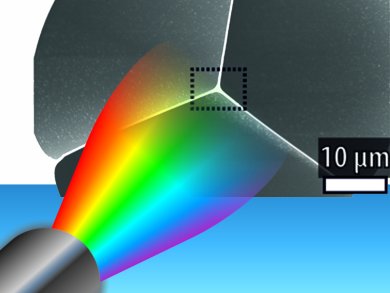Optofluidic microdevices where light and fluids can interact for spectroscopic or photoactivation purposes are excellent platforms for photocatalysis and in situ reaction analysis. Photonic crystal fiber (PCF) has emerged as a new class of optical fiber for such devices.
Bastian J. M. Etzold and co-workers, Excellence Cluster Engineering of Advanced Materials, Erlangen, Germany, describe how both homo- and heterogeneous catalysis are performed with ultra-high power densities at moderate laser powers in the new PCF design of cladding surrounding a waveguide of small core diameter (pictured). Chemical samples are introduced to micrometer-sized holes in the PCF, overcoming the limited light-sample interaction or leakage of light typical to conventional optical fibers.

Schematic of a conventional 1 cm cuvette and a 20 μm core kagomé hollow-core PCF (not to scale).
Dispersed catalytic systems in PCF enable advanced oxidation processes such as the degradation of organic pollutants. PCF-immobilized catalysts, for example in the supported ionic liquid phase, catalyze key reactions such as hydroformylations, hydrogenations, carbonylation, hydroaminations, Friedel-Crafts alkylations, and the water-gas shift reaction. Metal nanoparticles can also be deposited in PCFs, for example, gold or silver are used to form surface-enhanced Raman scattering-active fibers.
Ingeniously, this design, compared to the conventional centimeter-sized cuvettes, also improves quantitative photospectroscopic reaction analysis, enabling the detection of analytes in ultra-low concentrations.
- Chemical and (Photo)-Catalytical Transformations in Photonic Crystal Fibers,
Matthias Schmidt, Ana M. Cubillas, Nicola Taccardi, Tijmen G. Euser, Till Cremer, Florian Maier, Hans-Peter Steinrück, Philip St. J. Russell, Peter Wasserscheid, Bastian J. M. Etzold,
ChemCatChem 2013, 5, 641–650.
DOI: 10.1002/cctc.201200676




